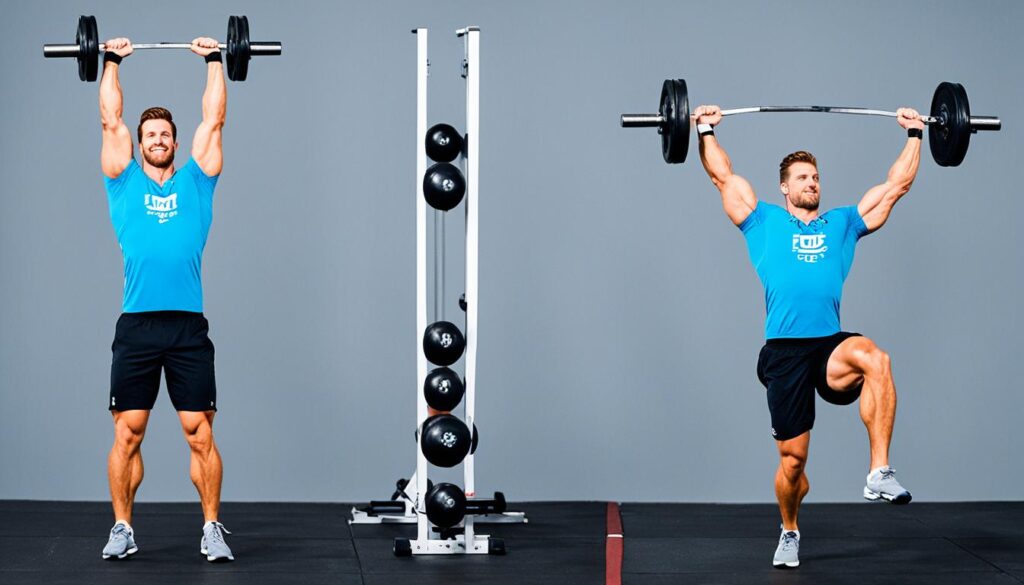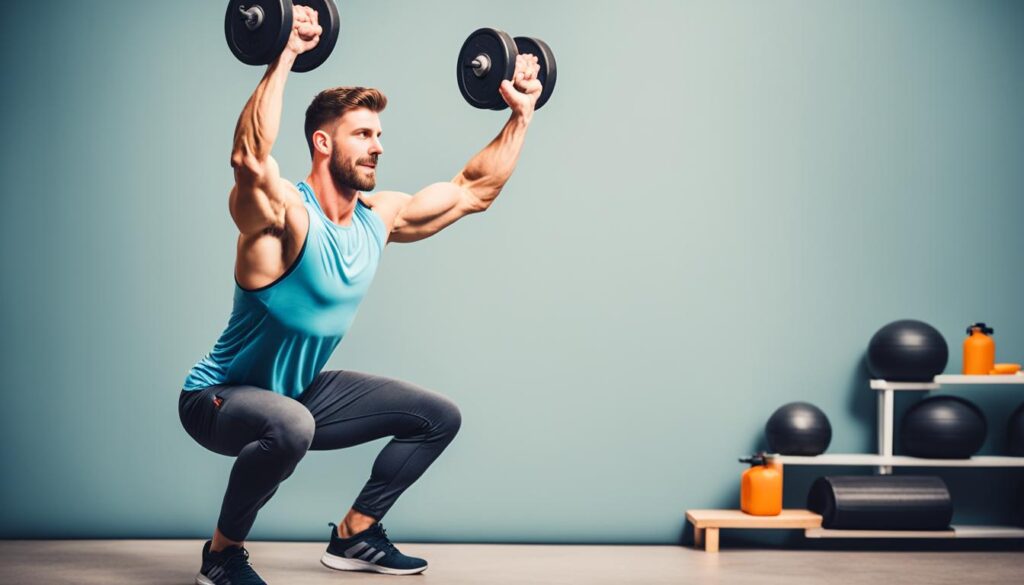Unlock the power of functional fitness to change your everyday life. It’s not just about going to the gym for looks. It’s about making your body work well with your daily tasks. By learning functional fitness routines, you’ll get stronger, more mobile, and balanced. This will change how you move, work, and play.
No more feeling held back by your body. Functional fitness workouts copy the movements you do every day, like carrying heavy bags or climbing stairs easily. They focus on big exercises and using your own body weight. This builds the strength and coordination you need for life’s challenges.
Functional fitness does more than just make you strong. Adding drills, core exercises, and balance training lowers injury risk. This means you can stay active and pain-free for a long time. Get ready to do your daily tasks with more energy and strength.
Table of Contents
ToggleKey Takeaways
- Functional fitness routines are designed to enhance everyday functionality and performance.
- Mastering compound exercises and bodyweight training can boost strength, mobility, and balance.
- Functional fitness reduces the risk of injury by improving stability, coordination, and proper movement patterns.
- Incorporating functional fitness into your daily life can revolutionize how you approach physical tasks and challenges.
- Functional fitness goes beyond just aesthetics, it’s about empowering your body to excel in real-world activities.
Understanding Functional Fitness
The idea of Functional Fitness is big in the fitness world. It’s all about doing exercises that are like the movements we use every day. This helps people do better in their daily tasks.
What is Functional Fitness?
Functional fitness is a way to exercise that makes you better at doing everyday tasks. It’s different from old-school workouts that only work one set of muscles. Functional fitness uses Compound Movements that work many muscles at once. This makes it more like how our bodies naturally move.
Benefits of Functional Training
- Improved strength and power for everyday activities
- Enhanced Mobility Drills and joint flexibility
- Better balance, coordination, and stability
- Increased overall fitness and resilience for Everyday Activities
Adding functional fitness to your workout routine can make everyday tasks easier. It makes you stronger and more flexible. This way, you can handle daily challenges with more confidence.

| Benefit | Description |
|---|---|
| Improved Strength | Functional fitness exercises target multiple muscle groups, leading to enhanced overall strength and power for everyday activities. |
| Enhanced Mobility | The emphasis on Mobility Drills in functional fitness routines helps improve joint flexibility and range of motion. |
| Better Balance | Many functional exercises challenge your balance and stability, improving your ability to navigate various terrains and situations with ease. |
“Functional fitness is not just about looking good; it’s about feeling good and performing better in all aspects of life.”
Compound Exercises for Functional Strength
Building functional strength starts with compound exercises. These exercises work many muscles at once. They make your workouts more efficient and improve your fitness for everyday tasks.
Exercises like squats, deadlifts, and push-ups use many muscles together. This helps build muscle and makes daily activities easier.
Adding compound exercises to your workout routine boosts Functional Strength. They improve balance, coordination, and stability. These skills are key for everyday challenges.
Compound Exercises to Try
- Squats: A classic exercise that targets the quadriceps, hamstrings, and glutes. It helps with activities like climbing stairs or getting up from a chair.
- Deadlifts: This exercise works the muscles in your legs, back, and core. It boosts overall Muscle Activation and Functional Strength.
- Push-ups: A versatile exercise that strengthens the chest, shoulders, and triceps. It improves upper body Functional Strength for tasks like carrying groceries or opening doors.
- Lunges: A lower-body exercise that targets the quadriceps, hamstrings, and glutes. It builds Functional Strength for walking and climbing.
Adding these Compound Exercises to your workouts can make you stronger for everyday tasks. They help you handle daily challenges with ease and confidence.
| Exercise | Muscle Groups Targeted | Benefits for Functional Strength |
|---|---|---|
| Squat | Quadriceps, Hamstrings, Glutes | Improves lower-body strength for activities like climbing stairs and getting up from a chair. |
| Deadlift | Back, Legs, Core | Develops full-body strength for tasks like lifting and carrying heavy objects. |
| Push-up | Chest, Shoulders, Triceps | Enhances upper-body strength for activities like carrying groceries and opening doors. |
| Lunge | Quadriceps, Hamstrings, Glutes | Improves lower-body strength and balance for better walking and climbing abilities. |
Mastering these Compound Exercises helps you build the Functional Strength needed for everyday tasks. This makes daily life easier and more efficient.

“Functional fitness is not just about lifting heavy weights; it’s about training your body to perform the tasks you encounter in your daily life with ease and efficiency.”
Bodyweight Training for Everyday Life
Functional fitness helps you do everyday tasks better and easier. Using your own body weight as resistance is a great way to get fit. By doing key exercises, you’ll get stronger, more stable, and more mobile for daily life.
Push-ups and Variations
The push-up is key in bodyweight training and staying fit. It works the chest, shoulders, and triceps. This helps with carrying heavy things or opening stuck doors. Try different push-ups like incline, diamond, and decline to work out various muscles and keep things interesting.
Squats and Lunges
Squats and lunges mimic how we move every day. They strengthen your legs, glutes, and hamstrings. This makes it easier to climb stairs, pick up items, and stand up straight all day.
| Exercise | Benefits | Application in Everyday Life |
|---|---|---|
| Push-ups | Strengthens chest, shoulders, and triceps | Improves pushing and carrying ability |
| Squats | Strengthens legs and glutes | Enhances mobility for activities like sitting and standing |
| Lunges | Develops unilateral leg strength and balance | Improves stability and coordination for walking and climbing |
Adding these bodyweight training exercises to your routine boosts your functional strength. This makes everyday activities easier and more confident.
Mobility Drills for Flexibility
Mobility drills are key for any fitness plan. They help improve your movement and functional flexibility. They also lower the chance of getting hurt during daily tasks and workouts.
Getting better at mobility makes moving easier and helps keep your joints and muscles healthy. By doing mobility drills, you can reach your full physical potential. You’ll do everyday tasks more efficiently.
- Improve your range of motion in important joints like the hips, shoulders, and ankles.
- Boost your flexibility for smoother and more controlled movements.
- Lower the risk of muscle imbalances and injury prevention during workouts and daily activities.
- Help you do compound exercises with the right form and technique.
Adding mobility drills to your workout can greatly improve your health and performance. By focusing on this important part of fitness, you’ll move better, feel better, and reach your full physical potential.
“Mobility is the foundation of all movement. Without it, you’ll never be able to reach your full potential in any physical pursuit.”
Core Stability and Balance Exercises
Functional fitness is more than just getting stronger. It also means having a strong core and balance for everyday tasks. Adding core and balance exercises to your workout can boost your body control, posture, and help prevent injuries.
Planks and Variations
The plank is a key exercise for core strength. It works many muscles at once. By holding it right, you strengthen your abs, back, and shoulders. Try side planks, reverse planks, and plank walks to make it more challenging.
Single-Leg Exercises
Exercising on one leg helps improve balance and stability. Doing single-leg exercises like standing heel raises, single-leg squats, and single-leg deadlifts works your core, hips, and legs. These exercises prepare you for real-life challenges.
Adding core and balance exercises to your fitness routine boosts your physical skills. It also makes everyday life easier and more confident.
| Exercise | Benefits |
|---|---|
| Planks | Strengthens the core, improves posture, and enhances overall body control. |
| Single-Leg Exercises | Develops balance, stability, and unilateral strength for everyday activities. |
Functional Fitness Routines
Functional fitness is about doing exercises that match your everyday activities. It helps improve your physical skills. To make a good Functional Fitness Routines, mix exercises that work on strength, stability, mobility, and balance.
Here are key parts to include in your Functional Fitness plan:
- Compound Exercises: Use exercises like squats, deadlifts, and push-ups. They work many muscles at once, helping you move better and stronger.
- Bodyweight Training: Use your own weight to build strength and improve how you move every day. Try push-ups, lunges, and planks.
- Mobility Drills: Do stretching and mobility exercises to keep your body flexible. This helps you move easily in your daily life.
- Core and Balance Exercises: Work on your core and balance with planks, single-leg exercises, and balance drills. This makes your Functional Fitness Routines better.
With these elements, you can make a Customized Workouts plan. This plan fits your Lifestyle Integration and helps you move better and feel stronger every day.
| Exercise | Primary Benefits | Example Exercises |
|---|---|---|
| Compound Exercises | Improved functional strength, muscle activation, and movement efficiency | Squats, Deadlifts, Push-ups, Pull-ups |
| Bodyweight Training | Enhanced everyday movement patterns, muscular endurance, and body control | Push-ups, Lunges, Planks, Squats |
| Mobility Drills | Increased flexibility, range of motion, and injury prevention | Arm circles, Leg swings, Ankle mobility exercises |
| Core and Balance Exercises | Improved core strength, stability, and balance for daily activities | Planks, Single-leg Exercises, Dynamic Balance Drills |
“Functional fitness is about training your body to perform the movements you need to thrive in your daily life, not just look good in the gym.”
Injury Prevention Strategies
Functional fitness routines can boost your daily life, but it’s key to focus on preventing injuries. Keeping up with proper form and technique is vital for your safety and long-term success.
Proper Form and Technique
Mastering the right form and technique is key to a safe and effective functional fitness routine. Learning the correct way to do exercises helps you avoid injuries and gets the most out of your workouts. Always take time to learn the proper form for each exercise and pay attention to how you move during your routine.
Warm-up and Cool-down
Adding a good warm-up and cool-down to your routine can greatly lower injury risk. A well-planned warm-up gets your body ready for exercise. A cool-down helps your body recover and ease back into a resting state.
- Warm-up exercises should increase your heart rate, blood flow, and movement slowly.
- Cool-down activities, like light stretching and mobility exercises, help prevent muscle soreness and stiffness.
By focusing on injury prevention, you can safely add functional fitness to your daily life. This approach to exercise can transform your health and well-being.
| Injury Prevention Strategies | Benefits |
|---|---|
| Proper Form and Technique | Reduces the risk of common injuries, maximizes the effectiveness of exercises |
| Warm-up and Cool-down | Prepares the body for the workout, aids in recovery and reduces muscle soreness |
Incorporating Functional Fitness into Your Daily Life
Making functional fitness a part of your daily life is key to keeping it up. Start by finding ways to exercise during your daily activities. For example, do squats while brushing your teeth or lunges during TV commercials. This way, you stay active without needing extra time for workouts.
Try to make your daily tasks more functional. Carry your groceries in a backpack or use hand baskets instead of a cart. Choose to climb the stairs instead of the elevator when you can. These changes turn everyday actions into exercises, boosting your strength and mobility.
For lasting success, find fun and creative ways to stay active. Try walking meetings or bodyweight exercises during your lunch break. Invite your friends and family to join in on fitness challenges. This makes staying fit a fun, shared activity that keeps you motivated and on track. By integrating functional fitness into your daily life, you can build a healthy lifestyle that improves your well-being.
FAQ
What is the purpose of functional fitness routines?
Functional fitness routines aim to boost your physical skills for everyday life. They focus on exercises that mimic daily movements. This improves strength, mobility, and balance, making daily tasks easier.
What are the key benefits of functional fitness training?
Functional fitness training boosts overall strength and mobility. It also improves balance and stability. Plus, it helps prevent injuries and enhances daily activity performance.
How do compound exercises contribute to functional fitness?
Compound exercises work many muscles at once, building functional strength. They include squats, deadlifts, and push-ups. These exercises improve muscle coordination, vital for daily tasks.
What are some effective bodyweight exercises for functional fitness?
Push-ups, squats, and lunges are great for functional fitness. They strengthen muscles and improve balance. These exercises prepare your body for daily life challenges.
Why are mobility drills important for functional fitness?
Mobility drills boost flexibility and motion range. They help you move better, lower injury risk, and make daily tasks easier.
How do core stability and balance exercises contribute to functional fitness?
Core stability and balance exercises, like planks and single-leg exercises, are key. They enhance body control and posture. This prevents injuries during daily activities and physical tasks.
What are some tips for designing effective functional fitness routines?
Mix exercises that target different fitness areas, like compound movements and mobility drills. Tailor the routine to fit your needs and lifestyle for a balanced and sustainable program.
How can I prevent injuries when performing functional fitness exercises?
Use proper form and technique, and warm up and cool down. Start with lighter weights and gradually increase intensity. Listen to your body to avoid injuries.
How can I integrate functional fitness into my daily life?
Add bodyweight exercises to your breaks, mobility drills to your morning, and physical activity to daily tasks. Make functional fitness a part of your lifestyle.













